How to increase or decrease the acidity of the soil on the site: methods of acidification and deoxidation of the soil
So, you want to change the acidity of your soil, and, most likely, in the direction of lowering it, because the soil in your area is too acidic. This is an absolutely normal phenomenon, in other words, there is nothing wrong with it, most gardeners are faced with this. And in more southern regions, especially where there are arid conditions, on the contrary, you may find that the soil is too alkaline.
Next, you will learn how to increase or decrease the acidity of the soil, in other words, how you can deacidify the soil or, on the contrary, acidify it.
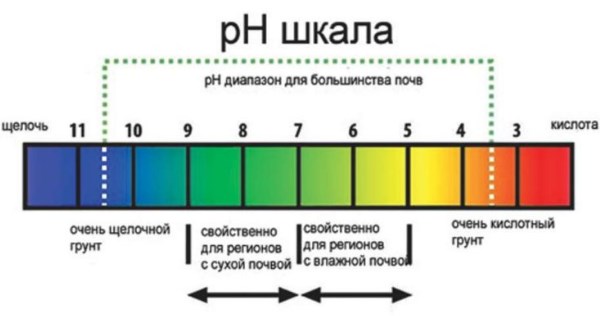
Content
What is soil acidity and how to determine it
As we already found out in the previous detailed article about how to find out the pH of the soil on the site, the acidity of the soil has a serious effect on the growth and development of plants. It is on its indicator that the availability and assimilation of various macro- and microelements of nutrition depends, in other words, at increased or decreased (more often) levels of soil acidity (pH) nutritional deficiencies.
As a rule, for normal growth and development, most plants (vegetables, berries and fruit crops) require neutral acidity soil (6-7 pH).
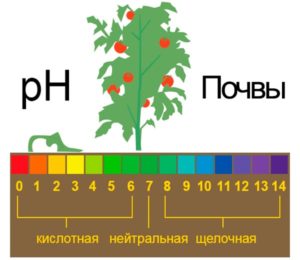
However, there are exceptions: these are all cultures family heather — heathers, blueberry, blueberries, lingonberries, cranberries, azaleas and rhododendronsand also erica, hydrangea and some conifers.
Change in soil acidity
Let's say that you have determined the acidity, which means that you can proceed to changing it in the required direction.
Let's immediately define the basic concepts and their synonyms:
- Deacidification of the soil = decrease in its acidity (increase in the pH level to 6-7) = neutralization of soil acidity (bringing it to normal) = liming (since lime materials containing calcium are used for deoxidation).
- Soil acidification = increasing its acidity (lowering the pH level to 4.5-5.5).
How to lower the acidity of the soil (make it neutral)
Most often, gardeners are faced with the fact that the soil in their garden is too acidic (pH below 5.5), which means that it needs to be deoxidized (increased pH). To do this, one of the deoxidizers is required to be added to the soil, they also say liming it.
When, how to properly and often deoxidize the soil
It is customary to deal with soil deoxidation in the fall.
So, first you need to scatter the deoxidizer (lime material) in an even layer over the surface of the garden bed, and then embed it in the soil (dig it up with a spatula or loosening it).
Important! Obviously, the effectiveness of liming directly depends on the uniform application of lime materials and their thorough mixing with the soil.
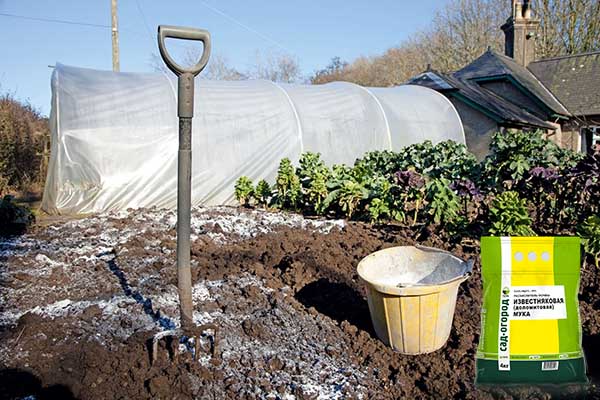
And a few more rules:
- All deoxidizers can be added under the autumn digging with organic fertilizers (manure, humus, compost), perhaps do not mix wood ash and manure.
- But to mix lime materials with phosphoric and nitrogen fertilizers not recommended as they will make them inaccessible to plants.
Worth knowing! Lime dissolves rather slowly in the soil, which means that its deoxidizing effect will be carried out gradually, in other words, the maximum effect will be achieved only 1-2 years after application (but not the next year!)
If you carry out deoxidation according to all the rules (add the required amount of lime material to the soil), then the effect will persist for 5-7 years (the heavier the soil, the longer), and then you will need repeat liming (deacidification) of the soil.
Interest Ask! Can a deoxidizer be added to the wells before planting?
This will obviously not be enough, since the root system of the plant will eventually go beyond a certain (diameter) hole. The deoxidizer should be applied along the entire perimeter of the garden.
How to deoxidize the soil: popular deoxidizers (lime materials)
To deoxidize the soil, as a rule, they use:
Use of dolomite (limestone) flour - This is the most popular way to deoxidize the soil.

- Slaked lime (fluff);
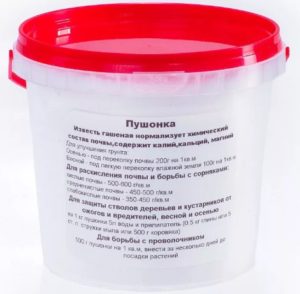
By the way! Ash can be used if you want to achieve the fastest possible effect.
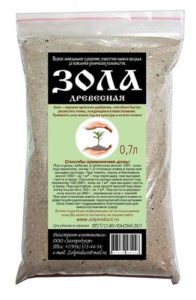
- A piece of chalk;
- Any other special deoxidizing agent (for example, Lime-Gumi deoxidizer, which, in addition to direct deoxidation, also heals and increases soil fertility).
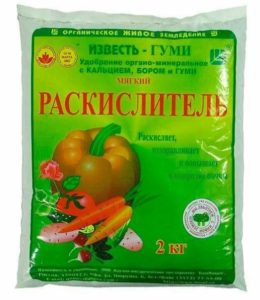
Important! No way to deoxidize the soil don't use baking soda... The fact is that an excess of sodium in the soil has a very bad effect on the physical properties of the soil.
The rates for the introduction of deoxidizers into the soil
Obviously, the rate of application of one or another deoxidizer depends on the initial acidity of the soil: the more acidic it is, the more deoxidizing (lime) substance is required.
Accordingly, before proceeding with deoxidation, you need determine the acidity of the soil.
And also from type of soil (texture): on light (sandy or sandy loam) soils, the application rate should be 1.5 times lessthan heavy (clayey or loamy).
For example, application rates slaked lime for heavy (loamy) soil:
- acidic (pH less than 4.5) - 500-600 grams per square meter beds;
- medium acidic (pH 4.5-5.5) - 450-500 g / m2;
- slightly acidic (pH 5.2-5.5) - 350-450 g / m2
Accordingly, for sandy loam (light) soils, the norms will be 1.5 less.
In wood ash contains almost 2 or 3 times less calcium (on average - 30-40%), than in lime and dolomite flour (up to 85%), in other words, the application rate increases to 0.7-1.2 kg per square meter. beds... But ash contains many other useful micro- and macroelements (potassium, phosphorus, magnesium, iron, sulfur, boron, manganese, zinc, molybdenum). The main advantage of wood ash is quick neutralization of acidic soil.
In other words, it makes sense to use wood ash only for rapid deoxidation of medium or slightly acidic soil (pH 4.5-5.2 or 5.2-5.5).
Application rates dolomite (limestone) flourare usually indicated on the packaging.
By the way! The site already has detailed material about how to use dolomite flour for soil deoxidation.
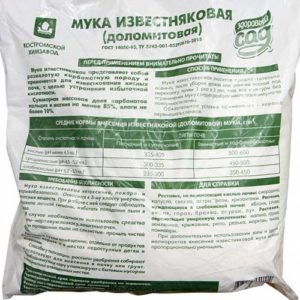
With regard to application rates Deoxidizer Lime-Gumi, then again everything is on the back of the package.
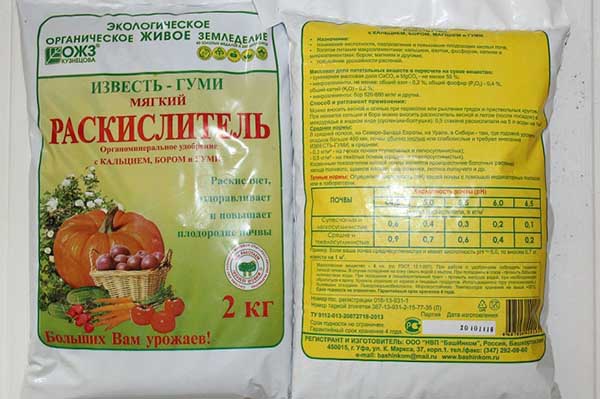
How to acidify soil (make it more acidic)
Of course, the problem of increased soil acidity is more common than when the soil is overly alkaline.
So what should be done by those gardeners whose soil is too alkaline (pH above 7-8, they also say "chalky" or "carbonate", that is, it contains a lot of calcium)?
However! Some plants love acidic or slightly acidic soil at all:
- all cultures family heather — heathers, blueberry, blueberries, lingonberries, cranberries, azaleas and rhododendronsas well as erica;
- hydrangea;
Interesting! The color of hydrangea inflorescences changes depending on the acidity of the soil: purple or blue - the soil is more acidic, pink or crimson - more alkaline.

- some conifers.
Note! Blackberry and honeysuckle no acidic soil is not needed.
If your soil is alkaline, here's what you can do to acidify it (increase acidity = lower pH):
- Horse sour peat (in no way deoxidized!);

- Gypsum;
- Sulfur (you can buy regular ground sulfur at a garden store or feed sulfur at a veterinary pharmacy). The application rate is about 100-250 g / m2. beds with subsequent shallow embedding, frequency - 1-2 times every 2 years.
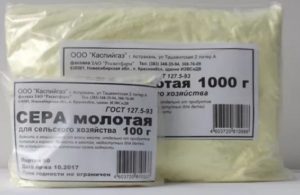
Important! Sulfur does not act instantly, but gradually, but the effect is long-lasting.
As nitrogen fertilization can and should be made regularly ammonium sulfate.
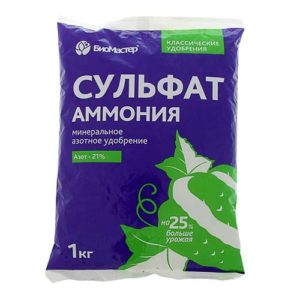
Also pH slightly lowers the application ammonium nitrate and urea (but only slightly).
Into irrigation water can add nitric or phosphoric acid (10-20 grams per 10 liters of water).
In this case, only plastic dishes should be used to prepare solutions.
You can also slightly acidify the soil with the following acidic solutions:
Important! The effect of their use is instant, but rather short-lived (short).
- slightly acidic solution electrolyte or sulfuric acid (10-20 ml per 10 liters of water);
Important! In no case should you use the electrolyte drained from the battery, since it contains lead, antimony and other heavy metals.
No used, only fresh!
- apple cider vinegar (100 ml of 9% vinegar per 10 liters of water);
- citric acid (20-40 g per 10 l of water).
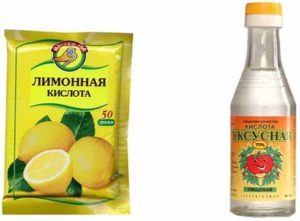
Advice! Moreover, it is very desirable to additionally add to the above solutions iron chelate or inkstone... Those. prepare a solution of ferrous sulfate solution (50-200 grams), where you add citric acid (1 teaspoon or tablespoon) to 10 liters of water. Then the effect will be more lasting.
As for the frequency of introducing such fast acidifiers, as a rule, they are introduced every 2-4 weeks, at least 2-4 times per season.
Well, now you know how to change the acidity of the soil to suit your needs (plant requirements). This process is not quick, so please be patient. Good luck!

